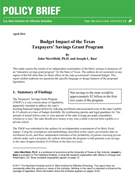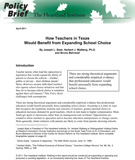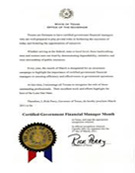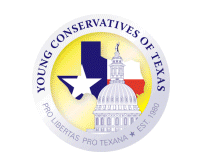Taxpayer savings grants are a win-win for both students and Texas taxpayers saving the state $2 Billion over the next two years. Every student is unique with different interests, abilities and educational needs. Providing parents voluntary options in education benefits students, the state budget, the Texas economy, and Texas taxpayers. This voluntary program decreases school expenses to help cover our school budget shortfalls thereby leaving more money on a per student basis in the system. Read More
Frequently Asked Questions
1. What is the Texas Taxpayer Savings Grant Program?
It is a proposed $2 billion voluntary savings program. Parents can transfer their child from a public school to a private school and use a Taxpayer Savings Grant to pay the tuition. The state saves $2 billion over the next two years by saving an average of $3,429 for each student who chooses to take the grant.
2. How much money will the Texas Taxpayer Savings Grant Program save the State of Texas?
Researchers estimate that the program will save more than $2 billion over the next two years based off of actual participation rates of 6 percent to 8 percent in other school choice programs across the country (Milwaukee and Edgewood San Antonio). Transaction fees will also be reduced by up to 10 percent through re-negotiations with participating processing banks. For more details see the Taxpayer Savings Grants Program budget savings study by the Heartland Institute at: http://TaxpayerSavingsGrants.org/
3. Who is eligible to participate in the voluntary program?
All parents with children currently enrolled in a Texas public school are eligible to participate. In addition, all students enrolling in kindergarten or first grade, or previously reveiving a grant are eligible to attend.
4. How is the savings grant calculated?
The savings grant is equal to the amount of actual tuition at the private school or 60% of the state average per-student maintenance and operations expenditure, whichever is less. In 2009-2010, the state average operating expenditure was $8,572 per student and 60% of that amount is $5,143. The State saves the other 40%.
5. What is the amount of the savings grant?
It is equal to the amount of actual tuition at the private school or $5,143, whichever is less.
6. What if the tuition at a private school is higher than the savings grant? Can a parent pay the difference?
Yes, parents can choose to pay the difference between the amount of the savings grant and the cost of tuition at their child’s school.
7. Who chooses the appropriate school for each participating student?
All decisions about educational choices are made solely by students and parents.
8. Who will administer the Texas Taxpayer Savings Grant Program?
The Texas Comptroller of Public Accounts will administer the Taxpayer Savings Grants Program. The Comptroller will adopt rules regarding application and reimbursement as well as rules to prevent fraud and abuse.
9. Where are the "savings" kept? In general revenue, in school finances or somewhere else?
The savings in general revenue can be used by the legislature for education, social services or any other legitimate state purpose.
10. How will Taxpayer Savings Grants affect schools in my area?
It will impact local schools exactly the same as if a student moved out of the district. The school will no longer receive attendance-based funding for that student (ADA funding), but will still have the local infrastructure funding paid for by bonds, which is $215 per student.
11. Will there be enough seats in private schools to meet the increased demand?
Absolutely. The "inputs" needed to expand existing schools or create new schools are plentiful. Nationwide, some 200,000 new teachers enter the market every year and there are many more applications than positions in virtually all school districts. The Edgewood school choice program and Texas charter schools have demonstrated that successful schools can increase capacity quickly and operate in office buildings, strip malls, day care centers, and other commonly available spaces. Milwaukee never experienced a shortage of private schools during the 21 years that its school choice program has operated. Now nearly 25% of students in Milwaukee attend private schools. Competition and choice has led to more efficient use of resources in the delivery of other public services meaning the same number of students could be taught with fewer resources. The free market is completely capable of meeting increased demand. The question should not be are there enough seats, but why are we not willing to give students and parents a choice.
12. Is this constitutional?
Yes. In Edgewood 4, the Texas Supreme Court stated that it was not necessary to provide education solely through districts and a state agency. It is the role of the legislature to determine how to provide the general diffusion of knowledge. In addition, The U.S. Supreme Court has clearly established the constitutionality of school choice plans that include public benefits, which the individual beneficiary may freely choose to use at religious schools. Zelman v. Harris Simmons, 536 U.S. 639 (2002). See this white paper for more information.
13. Will Taxpayer Savings Grants add new regulations to private schools?
No. There is no new regulation on private schools as a result of this proposal. Please see this one pager for more information at http://www.edchoice.org/Documents/SchoolChoice/FAQ10--Impact-on-Private-....
14. Do the savings come from the state share or local share?
The state gets 100% of the savings and pays the student grant.
15. Does the Taxpayer Savings Grant proposal use federal funds?
No. Taxpayer Savings Grants only uses state funds.
16. How will Taxpayer Savings Grants affect per-pupil spending, if the savings stays in education?
It is estimated that the Taxpayer Savings Grants program will increase per-pupil spending by $473 for each student remaining in public schools.
17. How will Taxpayer Saving Grants impact Texas’ per-pupil spending state ranking?
Texas’ rankings will increase 3 to 8 places in national rankings depending the metric. For more information see http://www.heartland.org/article/29988/Texas_Taxpayers_Savings_Grants_QA...
18. How will Taxpayer Savings Grants effect Texas public school teachers?
Public school teachers will see an increase in pay, better working conditions, more money spent in the classroom, a better matching of teachers, students and parents. In addition to greater job satisfaction, Texas public school teachers will see an increase in their annual compensation by $2,173 and as much as $12,000 due to competition for their services. For more information see "How Teachers in Texas Would Benefit from Expanding School Choice" at http://taxpayersavingsgrants.org/sites/taxpayersavingsgrants.org/files/T...






